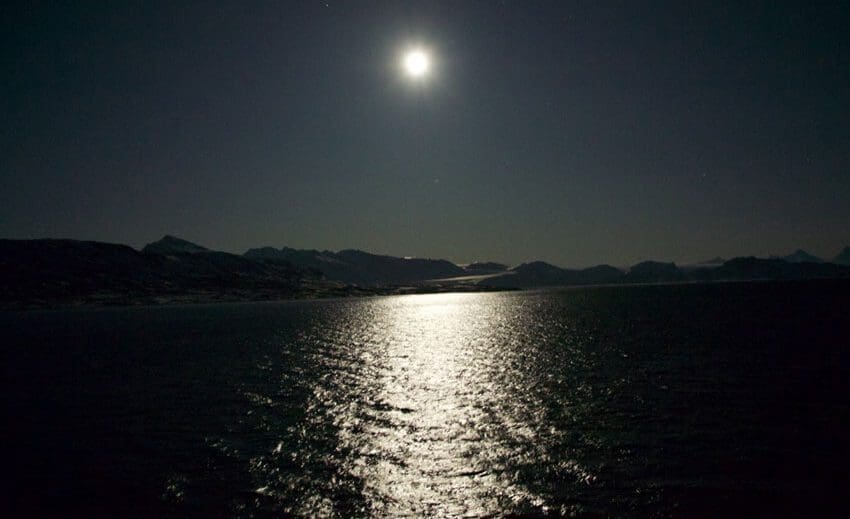While we wait for the light – part 2

Full moon in Kongsfjorden January 10, 2020. The moonlight gave such a clear and good view that you saw the entire Kongsfjorden and all the mountains surrounding it. Photo: Geir Johnsen.
While we wait for the light, not everything goes as we intended. Sometimes the world is simply not as we thought. And sometimes you are lucky and are in the right place at the right time without any plan behind it. This year’s polar night cruise is a good example of this.
21 February 2020
Text: Jørgen Berge (UiT The Arctic University of Norway, UNIS and NTNU), Geir Johnsen (NTNU and UNIS), Maxime Geoffroy (Memorial University, Canada), Tom Langbehn (University of Bergen and UNIS), Øystein Varpe (UNIS), Estelle Coguiec (UiT The Arctic University of Norway), Kim Last (Scottish Association of Marine Science) and Malin Daase (UiT).
In recent years, much research has been done on biological rhythms in connection with polar night and the distinct circadian rhythm found in many organisms. 24-hour zooplankton migration with a clear 24-hour cyclic pattern is a good example of this, but activity levels in Iceland scallop, mareel and other processes also show a clear 24-hour rhythm. In the dark polar night must such rhythms be regulated by biological clocks? How else should organisms manage to maintain a circadian rhythm?
Among other things, a lot of work has been done on krill in the Antarctic Ocean, which clearly shows that so-called clock genes play an important role in maintaining the circadian rhythm. We are also controlled by biological clocks – if you are used to eating dinner at half past five, your stomach says clearly that it is now time to eat when the clock is past half past five. The same can be seen in, for example, birds that are used to being fed at a certain time – they return to the feeding site at exactly the same time each day. The body’s biological clocks fit the time! Therefor it has been a clear expectation that in the organisms that are active throughout the polar night and which show a clear circadian rhythm, we will also find evidence that they are controlled by biological clocks. The alternative, a clear signal from the sun, seems too unlikely?
The Sun as Zeitgeber and lunar werewolves!
Despite a great deal of research into this, we have so far found little evidence that zooplankton that carry out daily migrations use biological clocks to control migration. Rather, we find evidence that the vast majority use the sun as so-called zeitgeber. In practice, this means that in Kongsfjorden for example, where krill and other zooplankton demonstrably carry out daily migrations throughout the polar night, the conductor is the sunlight. But not always directly. Sometimes the moon is also involved as a strong contributor, especially at full moon.
The moon has a slightly special cycle at high latitudes. In winter, when new, the moon will be below the horizon all day. When full, however, the moon circulates around the horizon for a short week. This means that periods of the polar night are interrupted by a continuous moonlight which, in clear weather, provides surprisingly much light throughout the day. During this period around the full moon, the moon is the dominant light source in the sky. But even though the moon is up all day, the angle between the horizon and the moon will vary. Therefore, for those organisms that control their behavior and circadian rhythm after daylight, they will switch from a 24-hour cycle to a 24.8-hour cycle. They turn into lunar “werewolves”!

Partial lunar eclipse
On this year’s polar night cruise, one of the main focus areas has been to be able to measure biologically relevant light from both sun and moon, as well as use advanced sonar to see how zooplankton regulates its behavior in relation to both natural and artificial light (light pollution). While we were in Kongsfjorden, where the full moon dominated the sky, we found out that there would be a partial lunar eclipse on January 10. This was information no one had known beforehand, but we had it verified on a poor satellite connection to Longyearbyen. The lunar eclipse was supposed to take place at 8:10 pm that night, and it should be about 90%. With people and equipment already rigged to study moonlight and movements in the water, the atmosphere became very great and enthusiastic when we realized this. What a great opportunity to see how the moonlight directly affects the organisms!
There was hectic activity on board to plan and organize to take advantage of this great and unexpected opportunity. All men on deck and out in small boats to make measurements away from the light polluting research ship! The only problem was that as the eclipse unfolded, Kongsfjorden remained bathed in moonlight, with no particular difference in sight. It turned out that this was not an umbral lunar eclipse (“real” eclipse where the moon enters the shadow of the sun), but a so-called penumbral eclipse where the moon enters into one of the side shadows of the earth. During such an eclipse, the entire moon remains visible, and it is difficult to distinguish it from an ordinary full moon.

Although the eclipse was not particularly impressive at first glance, the measurements showed a slightly different picture. During the maximum eclipse, the moonlight was reduced by almost 37% compared to the moonlight after the eclipse ended at 22:10. Quantity measurements of fish and zooplankton, on the other hand, did not show any changes in either amount, movement or placement in the water column. In other words, it was not possible to measure any clear response to the eclipse, possibly due to the fact that it was starry night and the water was clear. Most of the fish and zooplankton appeared to have initially dipped slightly down to avoid being eaten by night-active “werewolves”.
